Stories in verse are popular with readers of all ages. The books reviewed this week include picture books with the auditory appeal of a rhyming text paired with expressive artwork for young children and novels that fuse poetry and narrative in a more engaging and accessible format for older readers.
Ages 4–8
The Cook and the King. Julia Donaldson. Ill. David Roberts. 2019. Abrams.
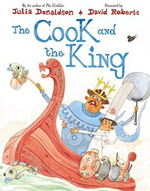 “There once was a very hungry king / Who needed a cook like anything,” but none of the offerings of applicants for the job satisfy him. Finally, the king gives Wobbly Bob (“I’m a bit of a wimp, but I’d love the job.”) a chance to make him some fish and chips. When it’s time to do each step in the preparation of the king’s favorite dish, however, Bob declares, “I’m scared! I’m scared! I’m terrible scared!” It is the king who ends up preparing the dish (from catching the fish and digging up the potatoes, to frying up and serving the fish and chips). After sharing the meal with Bob, the king is well pleased with the delicious dish—and the cook. “Congratulations, Wobbly Bob. / You may be a wimp, but you’ve got the job!” A clever, rollicking rhyme and colorful, expressive artwork make this book a read-aloud treat.
“There once was a very hungry king / Who needed a cook like anything,” but none of the offerings of applicants for the job satisfy him. Finally, the king gives Wobbly Bob (“I’m a bit of a wimp, but I’d love the job.”) a chance to make him some fish and chips. When it’s time to do each step in the preparation of the king’s favorite dish, however, Bob declares, “I’m scared! I’m scared! I’m terrible scared!” It is the king who ends up preparing the dish (from catching the fish and digging up the potatoes, to frying up and serving the fish and chips). After sharing the meal with Bob, the king is well pleased with the delicious dish—and the cook. “Congratulations, Wobbly Bob. / You may be a wimp, but you’ve got the job!” A clever, rollicking rhyme and colorful, expressive artwork make this book a read-aloud treat.
—CA
Hello, I’m Here! Helen Frost. Ill. Rick Lieder. 2019. Candlewick.
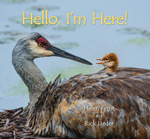 Employing the perspective of a newborn Sandhill crane, Helen Frost poetically describes the chick’s first moments after hatching as it boldly announces itself to the world (“Hello, I’m here!”) and discovers family (“Look, I’m standing! / One step. Another. / Hey, who’s this? / Are you my brother?”). Simple, four-line stanzas with an ABCB rhyme scheme on double-page spreads chronicle the chick’s adventures and discoveries in the marsh while loving crane parents shield it from possible dangers. Frost’s lyrics are accompanied by Rick Lieder’s stunning full-color photographs, which depict interactions between adult cranes and their chicks. Back matter provides additional information on Sandhill crane families.
Employing the perspective of a newborn Sandhill crane, Helen Frost poetically describes the chick’s first moments after hatching as it boldly announces itself to the world (“Hello, I’m here!”) and discovers family (“Look, I’m standing! / One step. Another. / Hey, who’s this? / Are you my brother?”). Simple, four-line stanzas with an ABCB rhyme scheme on double-page spreads chronicle the chick’s adventures and discoveries in the marsh while loving crane parents shield it from possible dangers. Frost’s lyrics are accompanied by Rick Lieder’s stunning full-color photographs, which depict interactions between adult cranes and their chicks. Back matter provides additional information on Sandhill crane families.
—SD
My Heart. Corinna Luyken. 2019. Dial/Penguin.
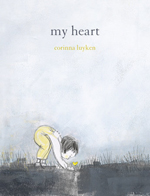 Author–illustrator Corinna Luyken scatters short lines of rhyming text across pages to deliver a timeless message of the heart’s role in our ability to love, heal, grow, and be self-guided. “My heart is a shadow, / a light, and a guide. / Closed or open . . . / I get to decide.” Luyken’s lyrical text, rich in metaphors, offers assurance to young readers that the heart is a place to turn to when shadows of self-doubt or sorrow creep in, and that it serves as a personal guide to help “mend” broken parts of one’s life. Lovely, monotype print illustrations (created with water-based inks and pencil) featuring a young child and camouflaged hearts enhance the mood of this delicate text as yellow and shades of grey, both separate and intermingling, echo the joys and sorrows our hearts endure.
Author–illustrator Corinna Luyken scatters short lines of rhyming text across pages to deliver a timeless message of the heart’s role in our ability to love, heal, grow, and be self-guided. “My heart is a shadow, / a light, and a guide. / Closed or open . . . / I get to decide.” Luyken’s lyrical text, rich in metaphors, offers assurance to young readers that the heart is a place to turn to when shadows of self-doubt or sorrow creep in, and that it serves as a personal guide to help “mend” broken parts of one’s life. Lovely, monotype print illustrations (created with water-based inks and pencil) featuring a young child and camouflaged hearts enhance the mood of this delicate text as yellow and shades of grey, both separate and intermingling, echo the joys and sorrows our hearts endure.
—SD
Never Trumpet with a Crumpet. Amy Gibson. Ill. Jenn Harney. 2019. Boyds Mills/Highlights.
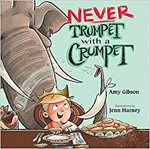 “Now if perchance Her Majesty / so happens to ask you to tea,” you should definitely not do what a group of animals do when they receive an invitation from the Queen. Colorful, digitally created cartoon illustrations show animal guests breaking the rules of good table manners. “No wolfing food or snapping jaws. / Use your fork and not your paws…. // And—goodness, gracious!—never trumpet / when you’re nibbling on a crumpet.” A double-spread illustration shows the appalled queen and a delighted young prince witnessing the elephant’s trumpeting sending the teapot, dishes, platters of food, and even a small guest flying from the table. Nonetheless, as the guests depart, the gracious Queen smiles, waves, and extends an invitation to come again before she falls asleep amid the wreckage.
“Now if perchance Her Majesty / so happens to ask you to tea,” you should definitely not do what a group of animals do when they receive an invitation from the Queen. Colorful, digitally created cartoon illustrations show animal guests breaking the rules of good table manners. “No wolfing food or snapping jaws. / Use your fork and not your paws…. // And—goodness, gracious!—never trumpet / when you’re nibbling on a crumpet.” A double-spread illustration shows the appalled queen and a delighted young prince witnessing the elephant’s trumpeting sending the teapot, dishes, platters of food, and even a small guest flying from the table. Nonetheless, as the guests depart, the gracious Queen smiles, waves, and extends an invitation to come again before she falls asleep amid the wreckage.
—CA
The Tall Man and the Small Mouse. Mara Bergman. Ill. Birgitta Sif. 2019. Candlewick.
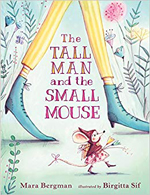 Although they live in the same house, the tall man and the small mouse have never met. The tall man did tall things that needed doing during the day, while the small mouse crept around at night doing small things that needed doing. When their paths cross unexpectedly one morning, the tall man realizes the small mouse’s help is just what he needs to complete work on the town’s broken clock. The pair discover they make a great team, become good friends, and “come rain or shine, whatever the weather, / they do the things that need doing / TOGETHER!” In the cheery illustrations (done in pencil and colored digitally) that complement Mara Bergman’s rhythmic narrative, Birgitta Sif effectively elongates details to parallel the man’s tallness.
Although they live in the same house, the tall man and the small mouse have never met. The tall man did tall things that needed doing during the day, while the small mouse crept around at night doing small things that needed doing. When their paths cross unexpectedly one morning, the tall man realizes the small mouse’s help is just what he needs to complete work on the town’s broken clock. The pair discover they make a great team, become good friends, and “come rain or shine, whatever the weather, / they do the things that need doing / TOGETHER!” In the cheery illustrations (done in pencil and colored digitally) that complement Mara Bergman’s rhythmic narrative, Birgitta Sif effectively elongates details to parallel the man’s tallness.
—SD
Tomorrow Most Likely. Dave Eggers. Ill. Lane Smith. 2019. Chronicle.
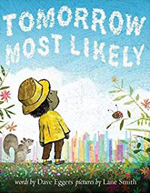 This whimsical bedtime story explores the promises of what the next day might bring as a young black boy is tucked into bed. “Tomorrow most likely / there will be a sky. / And chances are it will be blue. / Tomorrow most likely / there will be a squirrel. / And chances are his name is Stu.” The playfulness of Dave Egger’s rhythmic text is perfectly matched by Lane Smith’s colorful, textured illustrations that show the ordinary and extraordinary experiences the boy might have in his urban neighborhood tomorrow, including an encounter with a big bug who is worried about his missing friend, Stu. As the boy falls asleep, the story ends with a reassuring “Tomorrow most likely / will be a great day / because you are in it. / and Stu is okay.”
This whimsical bedtime story explores the promises of what the next day might bring as a young black boy is tucked into bed. “Tomorrow most likely / there will be a sky. / And chances are it will be blue. / Tomorrow most likely / there will be a squirrel. / And chances are his name is Stu.” The playfulness of Dave Egger’s rhythmic text is perfectly matched by Lane Smith’s colorful, textured illustrations that show the ordinary and extraordinary experiences the boy might have in his urban neighborhood tomorrow, including an encounter with a big bug who is worried about his missing friend, Stu. As the boy falls asleep, the story ends with a reassuring “Tomorrow most likely / will be a great day / because you are in it. / and Stu is okay.”
—CA
Wings. Cheryl B. Klein. Ill. Tomie dePaola. 2019. Atheneum/Simon & Schuster.
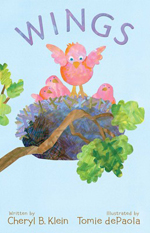 Cheryl B. Klein’s spare, rhyming text (one word per spread) and Tomie dePaola’s charming collage and mixed media illustrations tell the story of one baby bird’s determination to take flight for the first time. The timid bird “clings” to its nest, then finally “flings” itself downward in hopes of soaring and instead lands headfirst in a puddle. Almost defeated by the initial “stings” and “dings” of the first failed attempt, the sight of wriggling worms (“things”) brings hope to the baby bird as its hungry siblings wait back in the nest. “Things. / Brings? / Springs… / Sings!” The punctuation used in the poem eventually evolves from periods and ellipses to exclusively exclamation points, mirroring the change in tone from the young bird’s initial uncertainty to its later delight and triumph!
Cheryl B. Klein’s spare, rhyming text (one word per spread) and Tomie dePaola’s charming collage and mixed media illustrations tell the story of one baby bird’s determination to take flight for the first time. The timid bird “clings” to its nest, then finally “flings” itself downward in hopes of soaring and instead lands headfirst in a puddle. Almost defeated by the initial “stings” and “dings” of the first failed attempt, the sight of wriggling worms (“things”) brings hope to the baby bird as its hungry siblings wait back in the nest. “Things. / Brings? / Springs… / Sings!” The punctuation used in the poem eventually evolves from periods and ellipses to exclusively exclamation points, mirroring the change in tone from the young bird’s initial uncertainty to its later delight and triumph!
—SD
Ages 9–11
Birdie. Eileen Spinelli. 2019. Eerdmans.
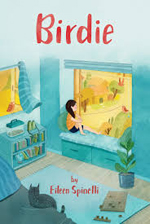 Twelve-year-old Birdie Briggs is having a difficult time dealing with the changes in her life which are becoming so confusing that even her love of birds—and playing Scrabble every Saturday with her best friend, Martin Stefano—can’t lift her spirits. Birdie and her mother have been living with her grandmother, Maymee, in the small town of Hadley Falls since the death of her father, a Philadelphia firefighter who died three years ago while on duty. Now her mother is dating a police officer; Martin has a crush on Nina, a new girl in town; and even Maymee has a boyfriend. In short free-verse poems, Birdie’s narration reveals how she comes to understand that change is a part of growing up and that making room for others in her life can be a good thing.
Twelve-year-old Birdie Briggs is having a difficult time dealing with the changes in her life which are becoming so confusing that even her love of birds—and playing Scrabble every Saturday with her best friend, Martin Stefano—can’t lift her spirits. Birdie and her mother have been living with her grandmother, Maymee, in the small town of Hadley Falls since the death of her father, a Philadelphia firefighter who died three years ago while on duty. Now her mother is dating a police officer; Martin has a crush on Nina, a new girl in town; and even Maymee has a boyfriend. In short free-verse poems, Birdie’s narration reveals how she comes to understand that change is a part of growing up and that making room for others in her life can be a good thing.
—CA
The Moon Within. Anita Salazar. 2019. Arthur A. Levine/Scholastic.
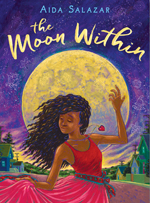 Celi Rivera, who lives in Oakland, California, and describes her heritage as “Black-Puerto Rican-Mexican,” loves dancing bomba and participating in the traditional Puerto Rican drum dance performances in which her father is a master drummer, but also has a troubling concern about another cultural expectation. Her mother insists that they will celebrate her first period with a traditional Mexican “moon ceremony.” When her childhood friend Magda Sánchez asks to be called Marco, identifying as one of the xochihuah, “people who danced between or to other energies than what they were assigned at birth,” Celi’s loyalty to her best friend is tested by her first crush, “black-xican” Iván’s cruel and insensitive jokes about Mar’s genderfluidity. Aida Salazar tells this engaging coming-of-age story with beautifully crafted first-person poems.
Celi Rivera, who lives in Oakland, California, and describes her heritage as “Black-Puerto Rican-Mexican,” loves dancing bomba and participating in the traditional Puerto Rican drum dance performances in which her father is a master drummer, but also has a troubling concern about another cultural expectation. Her mother insists that they will celebrate her first period with a traditional Mexican “moon ceremony.” When her childhood friend Magda Sánchez asks to be called Marco, identifying as one of the xochihuah, “people who danced between or to other energies than what they were assigned at birth,” Celi’s loyalty to her best friend is tested by her first crush, “black-xican” Iván’s cruel and insensitive jokes about Mar’s genderfluidity. Aida Salazar tells this engaging coming-of-age story with beautifully crafted first-person poems.
—CA
Ages 12–14
Soaring Earth: A Companion Memoir to Enchanted Air. Margarita Engle. 2019. Atheneum/Simon & Schuster.
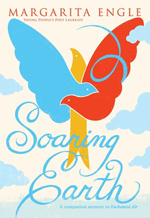 This companion memoir told in verse through a combination of simple and complex stanzas that occasionally mix in Spanish words conveys the identity struggle Margarita Engle faced as a Cuban-American teenager during the Vietnam War era. The first of the memoir’s six sections, “Wide Air,” reveals Engle’s yearning to visit her Cuban family (despite a travel ban), which was initiated by her struggle over identity—a struggle which was further compounded by additional adversities mentioned in the “Drifting” section, including discrimination, failed education, abuse, drugs, poverty, and conflict over war. Engle finally rediscovers herself and poetry when she realizes her passion for agronomy. “This time, I won’t give up. / I need to learn how to help feed the hungry / with roots, shoots, seeds, fruit, / and perseverance/” Short titles beautifully capture the mood and subject-matter of each poem.
This companion memoir told in verse through a combination of simple and complex stanzas that occasionally mix in Spanish words conveys the identity struggle Margarita Engle faced as a Cuban-American teenager during the Vietnam War era. The first of the memoir’s six sections, “Wide Air,” reveals Engle’s yearning to visit her Cuban family (despite a travel ban), which was initiated by her struggle over identity—a struggle which was further compounded by additional adversities mentioned in the “Drifting” section, including discrimination, failed education, abuse, drugs, poverty, and conflict over war. Engle finally rediscovers herself and poetry when she realizes her passion for agronomy. “This time, I won’t give up. / I need to learn how to help feed the hungry / with roots, shoots, seeds, fruit, / and perseverance/” Short titles beautifully capture the mood and subject-matter of each poem.
—SD
Ages 15+
White Rose. Kip Wilson. 2019. Versify/Houghton Mifflin Harcourt.
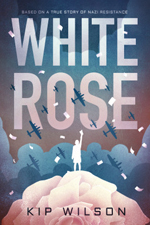 Based on a true story, this lyrical narrative recounts German Sophie Scholl’s involvement in White Rose, a World War II resistance group organized by her older brother Hans. To chronologize the historical events and build context, the novel in verse switches between “The End” (the period of interrogation and sentencing for the “treasonous” acts of creating and distributing anonymous wartime leaflets) and “Before” (Sophie’s upbringing and life events leading to her disapproval of the Nazi regime). “How can we expect / justice / in this world / if we’re not prepared to / sacrifice ourselves / for what is right?” Back matter includes a Dramatis Personae of Sophie’s family, members of White Rose, and individuals involved in the Gestapo interrogations and sentencing. A German glossary and bibliographical references are included.
Based on a true story, this lyrical narrative recounts German Sophie Scholl’s involvement in White Rose, a World War II resistance group organized by her older brother Hans. To chronologize the historical events and build context, the novel in verse switches between “The End” (the period of interrogation and sentencing for the “treasonous” acts of creating and distributing anonymous wartime leaflets) and “Before” (Sophie’s upbringing and life events leading to her disapproval of the Nazi regime). “How can we expect / justice / in this world / if we’re not prepared to / sacrifice ourselves / for what is right?” Back matter includes a Dramatis Personae of Sophie’s family, members of White Rose, and individuals involved in the Gestapo interrogations and sentencing. A German glossary and bibliographical references are included.
—SD
Skye Deiter is an elementary classroom teacher in Harrisburg, Pennsylvania, and a recent graduate from Pennsylvania State Harrisburg’s Masters in Literacy Education Program. Carolyn Angus is former director of the George G. Stone Center for Children's Books, Claremont Graduate University, in Claremont, California.
These reviews are submitted by members of the International Literacy Association's Children's Literature and Reading Special Interest Group (CL/R SIG) and are published weekly on Literacy Daily.